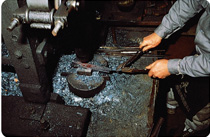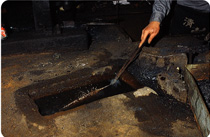Sakai Blades originated in the 5th century.
Sakai gained its fame as a tobacco knife manufacturer in the Edo Period.
Tobacco Knives and Sakai Blades
There are over 100 tumuli, including the famous Mozu Tumuli Area, and ancient burial mounds in Sakai. In the 5th century, blacksmiths were gathered in this region, to forge tools used to make the tumuli and this is believed to be the start of the art of smithery in this region.
SakaiÕs cutlery industry started to flourish in the 16th century when tobacco was introduced into Japan from Portugal . As Japan started cultivating its own tobacco plants, mass production of knives to chop the tobacco leaves was required. The first of such knives were made in Sakai.
Gradually, Sakai's high-grade knives came to exceed their foreign-made rivals in quality. During the Edo Period, the Tokugawa Shogunate hallmarked them with the words 'Sakai Kiwame', which guaranteed the product's authenticity, and sold them exclusively throughout Japan.
As a result, Sakai knives spread across the country, laying the foundations for the prestige of Sakai blades today.
Sakai Traditional Blades, which are made using the traditional Sakai knife forging technology, were appointed a 'Traditional Craft Product' by the Minister of International Trade and Industry (now The Minister of Economy, Trade and Industry) in March of 1982. Most professionals in Japan today use Sakai-made knives.
Also, in October 2007, "Sakai Blades" and "Sakai Traditional Blades" were registered as local community trademarks by the Japan Patent Office.
Knife Forging Process
-
Steel welding
 A steel, which is covered with a mixture of acidic powder is welded to hot iron at a temperature of about 900℃.
A steel, which is covered with a mixture of acidic powder is welded to hot iron at a temperature of about 900℃. -
Shaping
 The flattened iron is heated to about 600-700℃, flattened more and then shaped into the form of a knife.
The flattened iron is heated to about 600-700℃, flattened more and then shaped into the form of a knife. -
Annealing
After the blade is heated to 700-800℃, it is allowed to cool naturally in order to free it from internal stress and to prevent distortions. -
Cold hammering
The knife is hammered at room temperature to remove hammer marks that occurred during shaping and to smooth out the surface. -
Cutting
 The knife is placed on a cutting guide.
The knife is placed on a cutting guide.
All unnecessary parts are cut off. -
Grinding
An electric grinder and a file are used to smooth out areas with rough edges caused by the previous step, cutting. -
Mud coating
The knife is coated with mud and dried near the back of the furnace to ensure even cooling after tempering. -
Tempering • Annealing
 To toughen the steel, the knife is heated to 750-800℃ and cooled quickly by dipping it into a bucket of water. It is then heated to 180-200℃ and cooled naturally to increase its viscosity and strength.
To toughen the steel, the knife is heated to 750-800℃ and cooled quickly by dipping it into a bucket of water. It is then heated to 180-200℃ and cooled naturally to increase its viscosity and strength. -
Giving it an edge (Polishing)
 A knife goes through various stages of polishing before it is finished. It is rough polished, fine polished, medium polished, hazed, and then given a final polish.
A knife goes through various stages of polishing before it is finished. It is rough polished, fine polished, medium polished, hazed, and then given a final polish.

Types of Kitchen Knives
-

- Nakiri knife (Usuba knife)
- A knife with a wide, acute-angled edge. Suitable for cutting vegetables.
-

- Deba knife
- Has the thickness and weight suitable for cutting or slicing fish and chicken. The knife butt can be used to chop bones.
-

- Bunka knife
- A lightweight, easy-to-use, all-purpose knife that can be used for fish, meat or vegetables.
-

- Sashimi knife (Yanagiba knife)
- A knife for slicing sashimi. Its acute-angled edge makes it unsuitable for cutting hard objects like bones.
-

- Gyuto knife (Chef's Knife)
- Most suitable for slicing fish, meat and vegetables. Thin the tip of the knife can be used to carve intricate designs on vegetables.
-

- Petty knife (Paring knife)
- Used to peel fruit and to carve designs.
Sakai Traditional Blades
Because Japan is surrounded by water, a knife making industry that is suitable for fish and vegetable oriented food culture has developed. For example, in preparing sashimi, it is necessary to slice fresh seafood without damaging the cells by slowly pulling the knife towards you. The knife used in sashimi preparation is single-edged and the material is cut in towards the non-edged side so that the cells don't get damaged and the surface of the sliced material remains fresh and beautiful. A good knife doesn't ruin the material's original taste and texture.
There are 4 seasons in Japan and it is our custom to eat foods that can be harvested only in each season. To prepare various foods of each season into colorful and beautiful dishes, it was necessary to develop a wide variety of Japanese style knives.
However, Japan has low amounts of underground resources, such as iron for knives. Sakai was no exception, and "hammering" technology to effectively use the limited resources of steel naturally developed. The world famous Japanese swords are made through this "hammering" process. By crashing and breaking crystals into small parts, it is possible to strengthen steel and give it a beauty and sharpness as a craft made of fire, iron and water. Like Japanese swords, "Sakai Traditional Blades" are also made through this "hammering" process. Excellent "hammering" and "sharpening" technologies are the features of "Sakai Traditional Blades" that have a long tradition and unsurpassed quality that is acknowledged by other producing centers.
Even now, every "Sakai Traditional Blade" is handmade by craftsmen in Sakai. Forging and sharpening processes are carried out separately by each professional craftsman. They gain significant trust and support from professional chefs for the excellent sharpness of their knives.
"Sakai Traditional Blades" are designated as traditional crafts by the Minister of Economy, Trade and Industry of Japan. Also, in October 2007, "Sakai Blades" and "Sakai Traditional Blades" were registered as local community trademarks by the Japan Patent Office.
[Manufacturers' Association]
●Federation of Sakai Blades Commerce and Industry Associations
1-30, Zaimoku-cho Nishi 1-cho, Sakai-ku, Sakai 590-0937
Phone (072) 233-0118
https://www.sakaihamo no.or.jp/
[Facilities Open to the Public]
Sakai Hamono Museum
1-30, Zaimoku-cho Nishi 1-cho,
Sakai-ku, Sakai 590-0937
Phone (072) 227-1001
*The facility introducing the technology of hardware production and demonstrating its process.
Various types of kitchen knives and scissors are on display and available for sale.
Opening hours: 10 am - 5 pm
Closed: year end and New Year holidays







